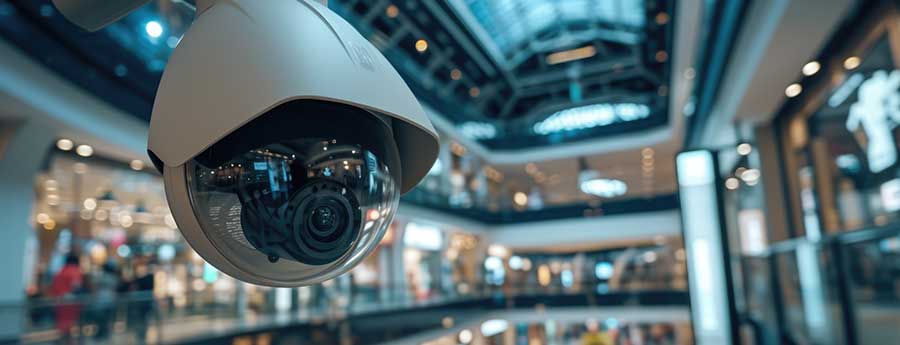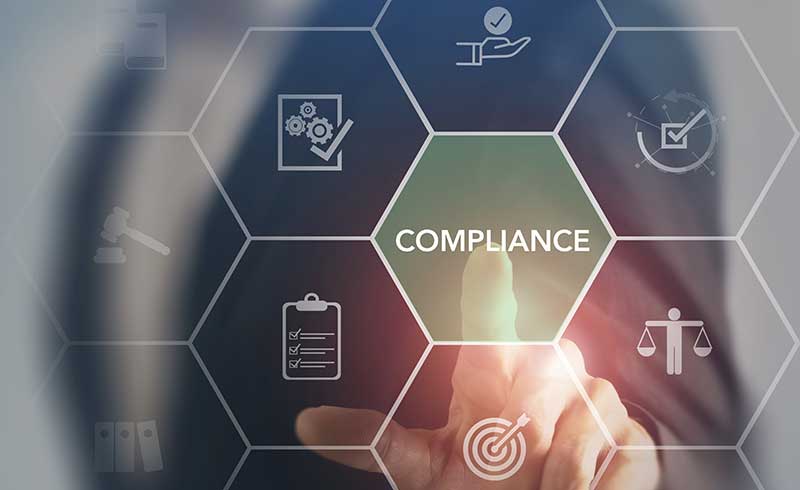Closed-circuit television (CCTV) systems are a staple in security management and surveillance across various industries. This technology plays a pivotal role in monitoring activities, deterring crime, and gathering evidence. In this article, we delve into what CCTV is, explore its different types, outline its benefits, and discuss the industries that commonly use it.
What is CCTV?
Closed-circuit television (CCTV) is a vital tool in modern security systems, employed extensively across various settings—from businesses and schools to public spaces and homes. Understanding how CCTV technology works can help users optimize its effectiveness and ensure they select the right systems for their needs.
What are the key components of a CCTV system?
A basic CCTV system comprises several key components that work together to capture and record video footage:
- Cameras: The most visible and crucial part of a CCTV system. Cameras can be either analog or digital (IP cameras). They capture video footage in the monitored area and send it to a recorder or a monitor.
- Lenses: Attached to cameras, lenses determine the field of view and level of detail in the images captured. Different lenses can provide various focal lengths and fields of view, from wide-angle to zoomed-in perspectives.
- Recording Device: In analog systems, this is typically a Digital Video Recorder (DVR). For IP systems, a Network Video Recorder (NVR) is used. These devices receive the video data from cameras and store it on hard drives for future playback or archival.
- Monitors: Used for live viewing of video feeds from CCTV cameras. Monitors can be standard computer screens or specialized security monitors.
- Cabling and Connectors: Essential for transmitting signals from the cameras to the recording device and monitors. In IP systems, data is usually transmitted over Ethernet cables, while analog systems may use coaxial cables.
- Power Supply: Cameras and other components require power, which is typically provided through direct electrical connections or, in the case of some IP cameras, via Power over Ethernet (PoE).

How does the CCTV systems work?
- Capturing Video: The process begins when CCTV cameras capture light through their lenses. The light hits the camera sensor, which converts it into a digital video signal. In analog cameras, this signal remains analog and is sent to the DVR, where it is converted into digital format for storage. IP cameras, on the other hand, convert the video signal into digital data internally.
- Transmission of Video: Once captured and converted, the video data is transmitted to a recording device. In analog systems, the video is sent via coaxial cables to a DVR. IP cameras send digital video data through Ethernet cables or wirelessly to an NVR or directly to a network.
- Recording and Storage: The DVR or NVR records the incoming video data, storing it on internal hard drives. Users can set up the recording to be continuous, at scheduled times, or triggered by motion detection, which helps conserve storage space and makes it easier to review important footage.
- Viewing Footage: Live or recorded footage can be viewed on connected monitors. With modern CCTV systems, users can also access video feeds remotely using smartphones, tablets, or computers. This is enabled by the DVR/NVR, which can connect to the internet and provide a secure stream to authorized users.
- Managing and Maintaining: CCTV systems can be managed locally at the DVR/NVR or remotely via software. Maintenance includes checking the integrity of recordings, ensuring cameras are correctly positioned and focused, and verifying that all components are functioning as expected.
What are the benefits of CCTV?
- Crime Deterrence: The presence of CCTV cameras on a property is a significant deterrent to crime. Potential offenders are less likely to target a location if they know their actions are being monitored and recorded.
- Monitoring and Surveillance: CCTV allows for the continuous monitoring of a location, helping to ensure that standards of service and safety are upheld. It is particularly useful in high-risk areas where constant surveillance is necessary.
- Evidence and Accountability: Recorded footage from CCTV systems can be invaluable in legal scenarios, providing evidence that can help in resolving disputes, identifying perpetrators, or understanding events as they unfold.
- Cost-Effective Security: Once installed, CCTV systems require relatively low maintenance and provide a cost-effective means of monitoring large areas where hiring security personnel might be financially impractical.
What are the latest advancements of CCTV technology?
Closed-circuit television (CCTV) systems are continually evolving, driven by technological advancements that enhance their effectiveness in security, surveillance, and operations management. Recent innovations have significantly improved the capabilities of CCTV systems, making them smarter, more connected, and efficient. This article explores the latest advancements in CCTV technology, highlighting how these developments are transforming the landscape of security surveillance.
Enhanced Image Quality
One of the most significant improvements in recent CCTV technology is the enhancement of image quality. Modern CCTV cameras now offer ultra-high-definition resolutions, such as 4K and even 8K, providing clearer and more detailed images. This level of detail is crucial for identifying faces, license plates, and other important elements in video footage, especially in critical security situations.
Artificial Intelligence and Analytics
Artificial intelligence (AI) has been a game-changer for CCTV technology. AI-powered CCTV cameras can analyze video content in real time to detect and classify objects, recognize faces, and even predict certain behaviors. For instance, AI algorithms can identify if a person is loitering in a sensitive area, if there is a crowd forming unexpectedly, or if an object has been left unattended for an unusual period. This proactive surveillance helps in preempting potential security threats.
Integration with IoT
The integration of CCTV systems with the Internet of Things (IoT) has opened up new possibilities for smarter surveillance. Cameras equipped with IoT capabilities can interact with other connected devices in a network to create a cohesive security system. For example, a CCTV camera can trigger an alarm if it detects motion after hours and simultaneously turn on lighting to capture clearer footage or deter intruders.
Cloud Storage and Computing
The shift towards cloud-based storage and computing is another significant trend in CCTV technology. Cloud storage offers scalable, flexible, and cost-effective storage solutions for CCTV footage. Additionally, cloud computing enables advanced video analytics, which can be processed on powerful cloud servers, reducing the need for high-spec local hardware.
Wireless and Mobile Technologies
Advancements in wireless technology have led to the increased use of wireless CCTV systems, which are easier to install and more flexible in terms of placement than traditional wired cameras. Additionally, mobile connectivity allows security personnel and business owners to access live feeds and recordings from anywhere in the world, using smartphones or tablets. This mobility enhances the convenience and responsiveness of security monitoring.
Cybersecurity Enhancements
As CCTV systems become more connected and integrated with the internet, cybersecurity has become a crucial focus. Modern CCTV systems are equipped with advanced encryption and security protocols to protect video data from unauthorized access and cyber threats. Regular firmware updates and secure authentication methods further ensure the integrity and confidentiality of the surveillance data.
Energy Efficiency
New CCTV cameras are designed to be more energy-efficient, using technologies such as LED lighting for night vision, which consumes less power. Some cameras also feature energy-saving modes that reduce power consumption when no motion is detected, contributing to lower operational costs and environmental impact.
What kind of Legal Implications are there using CCTV systems?
Closed-circuit television (CCTV) systems are invaluable tools for enhancing security and surveillance in both public and private settings. However, the use of CCTV involves several legal considerations that must be carefully managed to ensure compliance with privacy laws and regulations. This article explores the legal implications of using CCTV, discussing privacy issues, compliance with laws, and best practices for lawful use of surveillance systems.
Privacy Concerns
One of the primary legal considerations when using CCTV is the impact on privacy. Surveillance can sometimes infringe on people’s expectation of privacy, especially in areas where privacy is traditionally respected, such as in changing rooms or bathrooms. The key is to strike a balance between security needs and individuals’ rights to privacy.
Compliance with Data Protection Laws
In many jurisdictions, data protection laws, such as the General Data Protection Regulation (GDPR) in the European Union, impose strict requirements on the use of CCTV. These laws typically require that:
- Lawfulness of processing: CCTV must be used lawfully, fairly, and transparently. This often means that organizations must have a legitimate reason to install CCTV and must inform individuals that they are being recorded.
- Data minimization: Only the minimum amount of personal data necessary to achieve the CCTV’s objectives should be collected.
- Storage limitation: Footage should be stored for no longer than necessary, and secure measures must be implemented to protect the data.
- Accountability and governance: Organizations using CCTV need to demonstrate compliance with data protection laws, which can involve maintaining detailed records of CCTV use, conducting impact assessments, and ensuring appropriate policies are in place.
Notification and Signage
To comply with privacy laws, it is typically necessary to inform people when they are in an area where CCTV is operational. This is usually done through prominent signage that explains the presence of CCTV, the purpose of its use, and contact information of the operator.
Subject Access Requests
Individuals have the right to access personal data collected about them, including footage in which they appear. CCTV operators must have processes in place to allow individuals to make and receive responses to access requests. This might involve blurring other individuals in the footage to protect their privacy.
Use of CCTV in Employment
Employers who install CCTV in the workplace must consider additional legal implications, particularly related to employee rights. Employers must justify the use of CCTV, which generally involves demonstrating that its use is necessary and proportionate to address specific issues, such as security or safety concerns. Employees must be informed about the surveillance, and in some jurisdictions, employers may also need to consult with trade unions or worker representatives before installation.
Recording in Public Spaces
The use of CCTV in public spaces involves additional layers of complexity. While there is a reduced expectation of privacy in public areas, operators must still adhere to legal requirements, ensuring that the surveillance is justified and proportionate. In many cases, public authorities must conduct privacy impact assessments before deploying CCTV systems.
Best Practices for CCTV Usage
To navigate the legal landscape effectively, CCTV operators should adhere to several best practices:
- Conduct regular audits: Ensure that CCTV systems comply with laws and are used appropriately.
- Implement strict access controls: Limit who can access CCTV footage and under what circumstances.
- Regularly review and update CCTV policies: Keep policies in line with changes in law and technology.
- Engage with legal experts: Consult with legal professionals to understand and mitigate risks associated with CCTV usage.

How can businesses ensure their CCTV systems comply with data protection laws?
In an era where surveillance technologies are increasingly integral to business operations, the need to comply with data protection laws is critical. For businesses utilizing CCTV systems, this means implementing measures that adhere to stringent privacy regulations while still achieving security objectives. This article outlines practical steps businesses can take to ensure their CCTV systems comply with data protection laws, providing a secure and lawful surveillance environment.
Understand Applicable Laws
The first step in compliance is understanding the data protection laws that apply to your jurisdiction. For example, businesses in the European Union must comply with the General Data Protection Regulation (GDPR), while those in the United States may need to consider both federal and state-specific privacy laws. These laws dictate how surveillance data should be collected, stored, used, and shared.
Conduct a Data Protection Impact Assessment (DPIA)
Before deploying CCTV systems, conduct a Data Protection Impact Assessment. A DPIA helps identify and minimize the data protection risks of a project. For CCTV, this assessment should consider the necessity and proportionality of processing personal data. The assessment should also explore measures to mitigate risks to the rights and freedoms of individuals, such as data encryption and secure storage practices.
Establish a Clear Purpose for CCTV Use
Data protection laws require that CCTV is used for a clearly defined purpose. Businesses must document why they are using CCTV and ensure that its use is necessary for a specific purpose, such as security. Avoid using CCTV for reasons that were not initially disclosed without reassessing legal compliance and updating privacy notices.
Implement Privacy Notices
It’s crucial to inform individuals about the surveillance. Privacy notices should be visibly placed in areas covered by CCTV to alert individuals that they are being recorded. These notices should include information such as the identity of the business operating the CCTV, the purpose of data collection, and how individuals can request access to footage or lodge complaints.
Limit Access and Secure Data
Access to CCTV footage should be restricted to authorized personnel only, and businesses should keep a log of who accesses the data and why. Video data should be encrypted and stored securely to prevent unauthorized access. Additionally, businesses should establish a retention policy that complies with legal requirements, ensuring footage is kept no longer than necessary and then securely deleted.
Regularly Review and Update CCTV Policies
Compliance is not a one-time task. Regular reviews of CCTV policies and practices are essential to ensure ongoing compliance with data protection laws. This includes updating documentation, reassessing the necessity of CCTV systems, and ensuring all staff involved in operating CCTV are trained on privacy requirements.
Train Staff
Employees involved in operating or managing CCTV systems should receive training on data protection laws and company policies related to surveillance. This training should cover lawful handling of footage, responding to data access requests, and the importance of maintaining the confidentiality and integrity of surveillance data.
Respond Promptly to Access Requests
Individuals have the right to access personal data collected about them, including CCTV footage. Businesses should have procedures in place to efficiently handle these requests, ensuring responses are provided within the legal time frames. If footage includes images of third parties, businesses may need to obscure these individuals to protect their privacy unless it interferes with the purpose of the data collection.
Consult with Data Protection Authorities
When in doubt, consulting with data protection authorities can provide clarity and guidance on how best to implement CCTV systems in compliance with applicable laws. This proactive approach can prevent potential legal issues and strengthen data protection practices.
What Industries Utilize CCTV?
- Retail: Retail stores use CCTV extensively to prevent shoplifting, monitor customer traffic, and protect their assets.
- Banking and Finance: Banks employ CCTV to monitor branches and ATMs, enhancing security for both customers and staff by deterring robberies and fraud.
- Education: Schools and universities implement CCTV to monitor common areas, deter vandalism, and ensure the safety of students and staff.
- Transportation: Airports, train stations, and bus depots use CCTV for crowd monitoring, security checks, and to prevent terrorism.
- Healthcare: Hospitals use CCTV to monitor public areas, secure pharmacies and supply rooms, and ensure patient safety.
- Manufacturing and Industrial: These sectors use CCTV to ensure that safety protocols are followed, monitor production processes, and secure facilities.
In conclusion, CCTV systems are an integral part of modern security strategies across various business sectors. With advancements in technology, the capabilities of CCTV systems continue to expand, offering more sophisticated ways to monitor and protect assets. By understanding the different types of CCTV available and recognizing their benefits, businesses can effectively implement these systems to enhance security and operational efficiency.
If you would like more information about utilizing a CCTV system with your business, contact us today!



